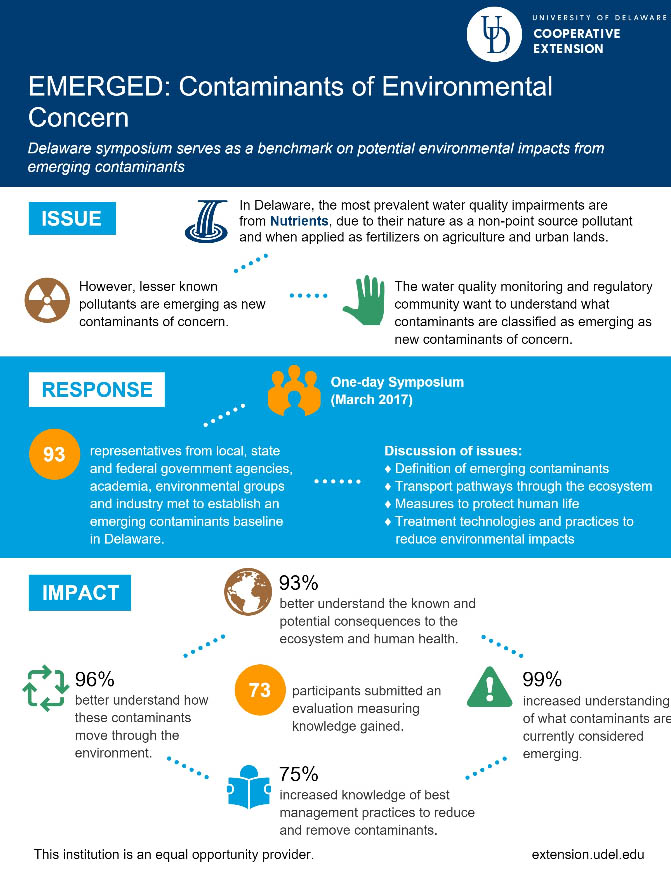
EMERGED: Contaminants of Environmental Concern (2017)
- Health & Well-being
-
Agricultural Programs
- Agribusiness
- Animal Science
- Beginning Farmer Program
- Commercial Crops
- Commericial Horticulture
- Delaware Soil Testing Program
- Disease Management
- Farm Vitality and Health Project
- Irrigation
- Nutrient Management
-
Insect Pest Management
- Insect Trapping Program
- IPM Hot Topics
- Commercial Field Crop Insect Management
- Commercial Field Crop Disease Management
- Commercial Fruit & Vegetable Crop Pest Management
- EIPM Implementation Projects
- Pollinators
- Research and Extension Demonstration Results
- Brown Marmorated Stink Bug (BMSB) Management, Research, and Resources
- Publications
- Pesticide Safety Education Program
- UD Plant Diagnostic Clinic
- Variety Trials
- Weed Science
- Certified Crop Advisor Program
- Poultry Biosecurity
- 4-H
-
Horticulture
- Climate Variability and Change
- Delaware Soil Testing Program
- Forestry
- Lawn and Garden
- Master Gardeners
- Master Naturalist Program
-
Nutrient Management
- Nutrient Management Certification
- Continuing Education for Nutrient Management
- Nutrient Management Planning Resources
- Commercial Nutrient Handler Resources
- Poultry Litter and Manure Management
- Turf Management
- Agriculture Notebook
- Horticulture Handbook
- Agriculture & Horticulture Handbooks
- Crop Production
- Soil Fertility
- Delaware Climate Change Coordination Initiative (DECCCI)
- Salt Impacted Agricultural Lands

ISSUE
In Delaware, the most prevalent water quality impairments are from nutrients, due to their nature as a non-point source pollutant and an abundance of agriculture and urban lands where they are applied as fertilizers. For decades, nutrients have been the focus of status and trends research, regulatory efforts, implementation of best management practices, and funding programs. But, lesser known pollutants are emerging as new contaminants of concern. The water quality monitoring and regulatory community expressed a need to understand what contaminants are classified as emerging as new contaminants of concern.
RESPONSE
A one-day symposium was held in March 2017 to provide an opportunity for 93 representatives from local, state, and federal government agencies, academia, environmental groups, and industry to establish an emerging contaminants baseline in Delaware. Experts in the region presented the definition of emerging contaminants, transport pathways through the ecosystem, measures to protect human life, and treatment technologies and practices to reduce environmental impacts. The afternoon featured projects by local researchers studying a variety of emerging contaminants.
IMPACT
The symposium served as a benchmark for Delaware’s efforts to understand and mitigate potential environmental impacts from emerging contaminants. Of the 93 participants, 73 (78%) submitted an evaluation measuring knowledge gained. Of those surveyed:
- 99% (72/73) indicated that increased understanding of what contaminants are currently considered emerging
- 96% (70/73) better understand how these contaminants move through the environment
- 93% (68/73) now have a better understanding of the known and potential consequences to the ecosystem and human health
The majority of participants felt they increased their knowledge of the local monitoring programs (89%; 65/73), how contaminants are regulated for drinking water (75%; 55/73), and best management practices to reduce and remove them (75%; 55/73). Despite the information shared, unknowns and uncertainties about emerging contaminants still exist. Research needs were identified related to fate and transport of contaminants, overall effects in the ecosystem, inter-relationships of mixing in the environment, and the prospect that replacements may also have negative environmental effects.
The University of Delaware is an Equal Opportunity Institution and Provider. Visit UD’s Office of Equity & Inclusion to learn more.
Additional Links
531 South College Avenue Newark, DE 19716 (302) 831-2501
